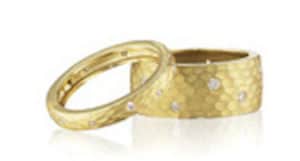
You may remember from one of our previous blog posts that the weight of diamonds is measured in carats. Well, confusingly, the word “karat” is also applied to gold.
In diamonds, it’s a measure of purity whereas, with gold, it’s a measure of weight. Sometimes the word is also spelled with a C when applied to gold, but using the K makes it at least slightly easier to denote units of weight vs. units of purity.
Is your head spinning yet? Never fear, your expert jewelers at Copeland Jewelers are here to explain!
How Karats Are Measured With Gold
The word “karat” comes from the same source as the word “carat” that denotes the weight of gems: the carob seeds that were used in ancient times to measure weight.
Around a thousand years ago one German mark coin weight 24 carats and was made of pure gold.
As it became easier and more popular to combine gold with other metals, people became concerned with measuring gold’s purity and co-opted the word “carat,” eventually changing the first letter for clarity’s sake.
One karat is equal to 1/24 pure gold. The most common karats for fine jewelry are 10-karat, 14-karat, and 18-karat.
- 10-karat gold is 41.7% pure gold, and the other 58.3% is made of other metals.
- 18-karat gold is 75% pure and 25% other metals.
- Gold that is 100% pure is referred to as 24-karat.
Sometimes jewelry is made from 24-karat gold, but it should only be worn on rare occasions and must be cared for extremely carefully to avoid damage.
Sometimes the non-gold metals that make up a gold alloy are specifically formulated to change the color of the finished product. For example, pink or rose gold is achieved with higher concentrations of copper; white gold is made with nickel; green gold comes from silver and zinc combined with pure gold.
Gold Is Probably Softer Than You’d Think
Gold is a very soft metal, which means that pure gold can be problematic when it comes to making jewelry (or any other item that will be used a lot in different environments).
Pure gold is easy to bend or scratch (remember the stereotypical image of the pirate biting into a gold coin to see how soft it is?). This means that if your jewelry is made from pure gold, you’re likely to end up with pitted pendants, folded rings, and marked-up bracelets – and heaven forbid you accidentally drop an earring back and then step on it!
To combat this issue, most gold jewelry and coins are made from alloys or mixtures of different metals. Commonly, gold is alloyed with copper and/or silver, which are, of course, still high-quality materials.
